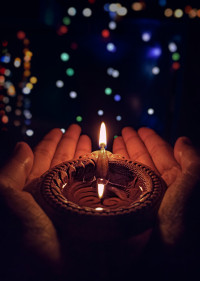As it is
The bite-sized myopia of poetry
The frontrunner of new culture of ‘Insta-poets’, Rupi Kaur’s work do not add anything to the larger poetic narrative..jpg&w=900&height=601)
Bibek Adhikari
Earlier this week, when Ruman Aalam in The New Republic declared Rupi Kaur—the Indian-Canadian poet known for her aphoristic poems on Instagram—as the ‘Writer of the Decade,’ all I could do was stare at the screen, unable to comprehend the looming dismal reality.
Aalam’s main argument is that her work is “within the parameters of a smartphone screen,” the only constraint modern readers are accustomed to. By embodying technology with contemporary life, Kaur has created scribblings (along with authentic sketches) about self-love, sexual abuse, feminism, and much more.
But does that explain the 3.5 million copies of the sale of her books? For one reason, Kaur’s writing is extremely accessible. A 15-year-old with little or no knowledge of poetry may cursorily scan her verses and explain what she’s trying to say. You don’t have to reach for a dictionary, scratch your head over a metaphor, or read the same line over and over. You don’t even have to be an English major to unknot the tangled strings of allusions, myths, and symbols—because there aren’t any. Another reason is, she likes to state the obvious, hacking prose into enjambed lines that look like poetry. For instance, let’s take this work of hers: “the rape will / tear you / in half // but it / will not / end you.” Her lazy use of line breaks is self-evident. And what’s more—she’s making a commonplace sentence sound profound: a perfect feat for her readers who nibble on her bite-size Instapoetry.
Moreover, she speaks to millions of her readers because she makes them think that she cares. By infusing the elements of love and sex as well as feministic adages, she helps her readers make sense of this incomprehensible world. If you are unsure how to pour your heart out to your recent highschool crush, Kaur has a solution for it. Or, say there’s a black hole in your heart that’s eating you up from the inside, don’t worry, Kaur has got you covered. Maybe someone abused you, either at home or workplace, Kaur will simplify the trauma in sweeping generalisations. So, all you’ve got to do is sit back, swipe across the screen (or flip the pages, if you may), enjoy the new form of avant-garde poetry—the only way the world is going to read and write from now on.
That’s her strength.
However, if you are a literary snob, you will soon realise there’s nothing more than what is apparently put on the screen or page. Unlike the poems of William Carlos Williams, there is no energy beneath the prosody of Kaur’s. Unlike his poems, readers don’t find any subtext—the powerful interplay of themes and ideas—beneath her work. What she states is obvious and vacuous. Read all of her poems from Milk and Honey or The Sun and Her Flowers, and you’ll notice how she likes to state the banal without any hint at craftsmanship. Her poems are byproducts of inefficiency and ignorance.
Let’s look at one of her works: “the way you speak of yourself / the way you degrade yourself / into smallness / is abuse.” Overlooking the simplistic use of diction and all too obvious idea, one can still question—is her poetic engagement of trauma a defence of her lack of subtext or style? Is she trying to “sell” the idea of sexual abuse by masquerading a self-help tone in her poems? Is it because she speaks of female trauma that other female readers are able to connect to her words?
Since she engages her readers with bits and pieces of her personal trauma, they fail to see the bad quality of her language—the formulaic and shallow use of words. That makes her look like an authentic writer describing an image that comes from her personal space. From marriage to sex to rape to femininity to race, she has marketed herself as a self-help poet, who’s willing to speak the pain of a million other women.
She openly rejects the literary establishments and doesn’t like to be compared with other mainstream poets. By ridiculing the literary magazines in her interviews, and by self-publishing, she has made a mark. As for the question of why she writes what she writes, she puts it quite bluntly—“I write to document that we were here.” By “we” she’s speaking of women, who went through pain and took time in healing. In that sense, she thinks she’s representing the whole womankind—the worst possible folly a writer can commit—and she believes she’s speaking on behalf of them.
As for the style that is so important in poetry, Kaur lacks the basics. On her website, she explains the reason for using only lowercase and periods in her poetry. Since she wanted to write in her mother tongue, Punjabi (but failed), she adopted the linguistic sensibilities of that language. As the Gurumukhi script in Punjabi only has lowercase and period, she used that concept in English. Also, she has little or no idea why she’s using all those random line breaks and enjambments. Paying no heed to the heritage of words, she resembles an amateur who sits in front of the piano for the first time and hits whatever key in whatever way she likes.
To borrow Oscar Wilde’s famous saying and twist it to suit the context—“There’s no such thing as a subjective poem. Poems are either well written or badly written.”
And when it comes to Kaur’s poetry, they are absolutely badly written with lackluster language and the illusion of profundity—all kept together using a simple type font on a white background accompanied by a cute little drawing.
But some people need cute little lines to make sense of their cute little worlds, and that’s okay. Still, the unvarnished truth is, if Rupi Kaur is the ‘Writer of the Decade’ for her soft readers of poetry, the decade is (probably) not a good one.
Adhikari is a poet based in Kathmandu. He tweets @bibek_writes.




 22.65°C Kathmandu
22.65°C Kathmandu










